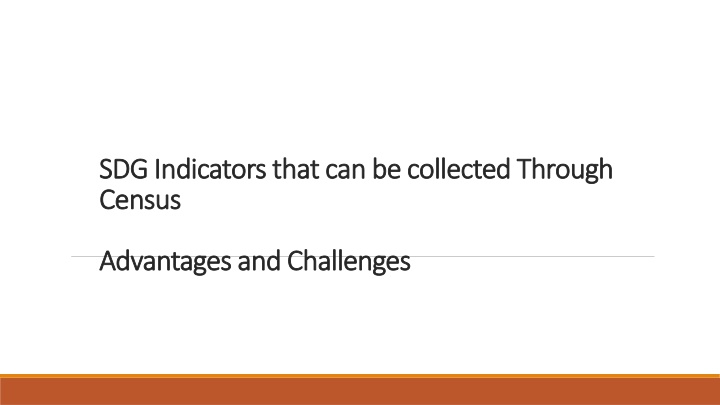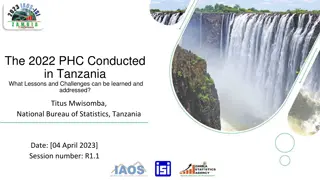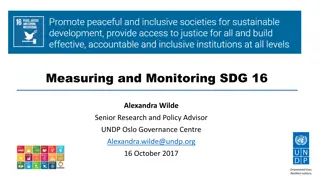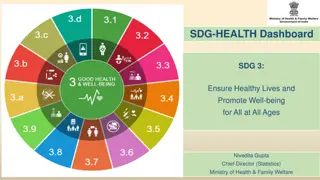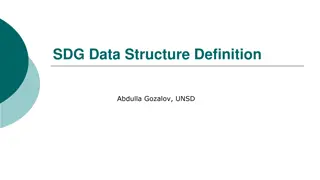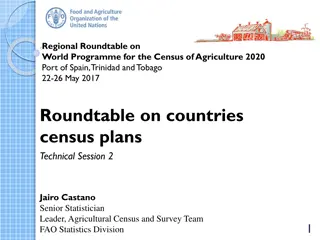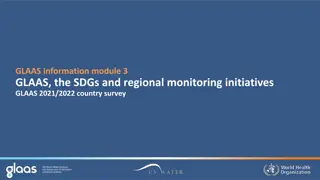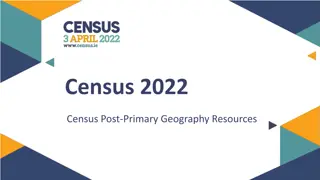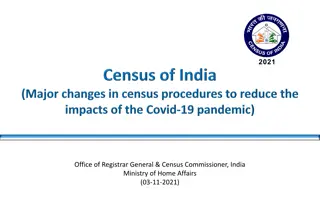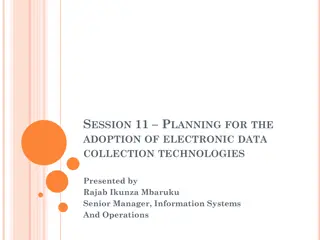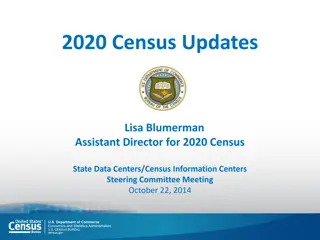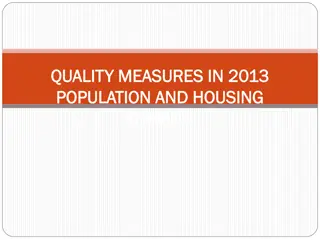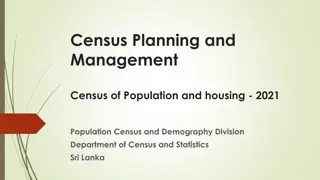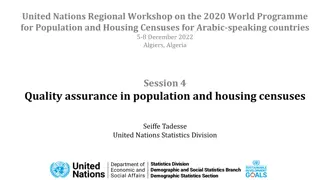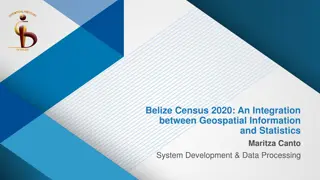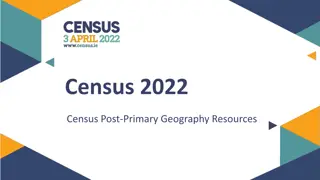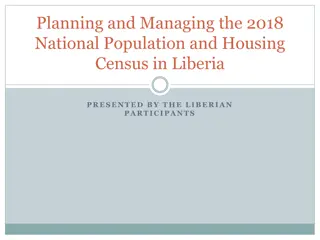SDG Indicators Collected Through Census: Advantages and Challenges
SDG indicators that can be collected through census data, focusing on key goals such as poverty eradication, ensuring healthy lives, promoting education, achieving gender equality, and managing water and sanitation sustainably. Learn about specific indicators related to population access to basic services, maternal mortality ratio, education participation rates, gender equality in leadership, and water service sustainability. Discover how census data collection can address these crucial Sustainable Development Goals, along with the advantages and challenges associated with this approach.
Download Presentation

Please find below an Image/Link to download the presentation.
The content on the website is provided AS IS for your information and personal use only. It may not be sold, licensed, or shared on other websites without obtaining consent from the author.If you encounter any issues during the download, it is possible that the publisher has removed the file from their server.
You are allowed to download the files provided on this website for personal or commercial use, subject to the condition that they are used lawfully. All files are the property of their respective owners.
The content on the website is provided AS IS for your information and personal use only. It may not be sold, licensed, or shared on other websites without obtaining consent from the author.
E N D
Presentation Transcript
SDG Indicators that can be collected Through SDG Indicators that can be collected Through Census Census Advantages and Challenges Advantages and Challenges
Goal 1. End Goal 1. End poverty in all its forms poverty in all its forms everywhere everywhere 1.4.1 Proportion of population living in households with access to basic services
Goal 3. Ensure healthy lives and promote Goal 3. Ensure healthy lives and promote well well- -being for all at all being for all at all ages ages 3.1.1 Maternal mortality ratio 3.2.1 Under-five mortality rate 3.2.2 Neonatal mortality rate 3.7.2 Adolescent birth rate (aged 10-14 years; aged15-19 years) per 1,000 women in that age group 3.c.1 Health worker density and distribution (Derived from Labour xx)
Goal 4. Ensure inclusive and equitable quality education Goal 4. Ensure inclusive and equitable quality education and promote lifelong learning opportunities for all and promote lifelong learning opportunities for all 4.2.2 Participation rate in organized learning (one year before the official primary entry age), by sex 4.3.1 Participation rate of youth and adults in formal and non-formal education and training in the previous 12 months, by sex 4.5.1 Parity indices (female/male, rural/urban, bottom/top wealth quintile and others such as disability status, indigenous peoples and conflict affected, as data become available) for all education indicators on this list that can be disaggregated 4.6.1 Percentage of population in a given age group achieving at least a fixed level of proficiency in functional (a) literacy and (b) numeracy skills, by sex (i.e. partial)
Goal 5. Achieve gender equality and Goal 5. Achieve gender equality and empower all women and empower all women and girls girls 5.5.1 Proportion of seats held by women in national parliaments and local governments 5.5.2 Proportion of women in managerial positions 5.b.1 Proportion of individuals who own a mobile telephone, by sex
Goal Goal 6. Ensure availability and sustainable 6. Ensure availability and sustainable management of water and sanitation for management of water and sanitation for all all 6.1.1 Proportion of population using safely managed drinking water services 6.2.1 Proportion of population using safely managed sanitation services, including a hand-washing facility with soap and water (partly)
Goal 7. Ensure access to affordable, reliable, Goal 7. Ensure access to affordable, reliable, sustainable and modern energy for all sustainable and modern energy for all 7.1.1 Proportion of population with access to electricity 7.1.2 Proportion of population with primary reliance on clean fuels and technology
Goal 8. Promote sustained, inclusive and sustainable Goal 8. Promote sustained, inclusive and sustainable economic growth, full and productive employment economic growth, full and productive employment and decent work for and decent work for all all 8.3.1 Proportion of informal employment in non-agriculture employment, by sex 8.5.2 Unemployment rate, by sex, age and persons with disabilities 8.6.1 Proportion of youth (aged 15-24 years) not in education, employment or training 8.7.1 Proportion and number of children aged 5-17 years engaged in child labour, by sex and age (Only working children!!!!)
Goal 9. Build resilient infrastructure, promote inclusive Goal 9. Build resilient infrastructure, promote inclusive and sustainable industrialization and and sustainable industrialization and foster foster innovation innovation 9.1.1 Proportion of the rural population who live within 2 km of an all-season road (Partial) 9.2.2 Manufacturing employment as a proportion of total employment 9.c.1 Proportion of population covered by a mobile network, by technology
Goal 11. Make cities and human settlements Goal 11. Make cities and human settlements inclusive, safe, resilient and sustainable inclusive, safe, resilient and sustainable 11.1.1 Proportion of urban population living in slums, informal settlements or inadequate housing (Need to define a slum) 11.2.1 Proportion of population that has convenient access to public transport, by sex, age and persons with disabilities 11.3.1 Ratio of land consumption rate to population growth rate (Partial)
Goal 16. Promote peaceful and inclusive societies for Goal 16. Promote peaceful and inclusive societies for sustainable development, provide access to justice for all and sustainable development, provide access to justice for all and build effective, accountable and inclusive institutions at all levels build effective, accountable and inclusive institutions at all levels 16.7.1 Proportion of positions (by sex, age, persons with physical disability and population groups) in public institutions (local and national legislatures, public service and judiciary) compared to national distribution 16.9.1 Proportion of children under 5 years of age whose birth have been registered with a civil authority by age
Goal 17. Strengthen the means of implementation and Goal 17. Strengthen the means of implementation and revitalize the global partnership for sustainable revitalize the global partnership for sustainable development development 17.8.1 Proportion of individuals using internet Proportion of countries that (a) have conducted at least one population and housing census in the last ten years (b) have achieved 100% birth registration and 80% death registration
Goals 2, 10, 13, 14 and 15 Goals 2, 10, 13, 14 and 15 None
Advantages and Disadvantages Advantages and Disadvantages Advantages Complete coverage International Comparability Provides trends Challenges Take long time to take place (10 years) A lot of the indicators are not covered (They can be obtained either through administrative or survey data)
